Population Genetics of the Emergence and Evolution of Allogenic Recognition During Fertilization
Abstract
1. Introduction
2. Materials and Methods
2.1. Modeling for the Emergence Process of Allorecognition Genes
2.2. Modeling of the Evolution of Allorecognition Genes
2.2.1. Divergence Through Mutation
2.2.2. Model with Divergent Alleles
2.3. Modeling the 2-Locus Situation
3. Results
3.1. Emergence Process of Allorecognition Genes
3.2. Process of Allorecognition Gene Evolution
3.2.1. Process of Divergence Through Mutations in Male/Female Genes
3.2.2. Behavior of the Model with Divergent Alleles
3.3. Simulation Using the 2-Locus Model
4. Discussion
4.1. Validation of Simulations with Analytical Results
4.2. Comparison with Observed Phenomena
4.3. Asymmetric Characteristics of Female and Male Recognition Molecules
4.4. Tolerance to Mutations and Molecular Evolution
5. Conclusions
Supplementary Materials
Author Contributions
Funding
Institutional Review Board Statement
Informed Consent Statement
Data Availability Statement
Acknowledgments
Conflicts of Interest
Abbreviations
| allorecognition | allogenic recognition |
| VC | vitelline coat |
Appendix A. Formulae for Generation Calculations
Appendix A.1. Models for Mutations in Male or Female Genes
Appendix A.2. Model with Divergent Alleles
Appendix A.3. Model with 2-Loci
References
- Iwano, M.; Takayama, S. Self/non-self discrimination in angiosperm self-incompatibility. Curr. Opin. Plant Biol. 2012, 15, 78–83. [Google Scholar] [CrossRef]
- Fujii, S.; Kubo, K.; Takayama, S. Non-self- and self-recognition models in plant self-incompatibility. Nat. Plants 2016, 2, 1–9. [Google Scholar] [CrossRef]
- Zhang, D.; Li, Y.Y.; Zhao, X.; Zhang, C.; Liu, D.K.; Lan, S.; Yin, W.; Liu, Z.J. Molecular insights into self-incompatibility systems: From evolution to breeding. Plant Comm. 2024, 5, 100719. [Google Scholar] [CrossRef]
- Sawada, H.; Saito, T. Mechanisms of Sperm-Egg Interactions: What Ascidian Fertilization Research Has Taught Us. Cells 2022, 11, 2096. [Google Scholar] [CrossRef]
- Harada, Y.; Takagaki, Y.; Sunagawa, M.; Saito, T.; Yamada, L.; Taniguchi, H.; Shoguchi, E.; Sawada, H. Mechanism of Self-Sterility in a Hermaphroditic Chordate. Science 2008, 320, 548–550. [Google Scholar] [CrossRef] [PubMed][Green Version]
- Sawada, H.; Saito, T.; Shimada, Y.; Nishimura, H. Fertilization mechanisms in hermaphroditic ascidians and nematodes: Common mechanisms with mammals and plants. Curr. Top. Dev. Biol. 2025, 162, 55–115. [Google Scholar][Green Version]
- Schoen, D.J.; Baldwin, S.J. Self-incompatibility and the genetic architecture of inbreeding depression. New Phytol. 2023, 237, 1040–1049. [Google Scholar] [CrossRef]
- Morgan, T.H. The genetic and the physiological problems of self-sterility in Ciona. J. Exp. Zool. 1942, 90, 199–228. [Google Scholar] [CrossRef]
- Scofield, V.L.; Schlumpberger, J.M.; Weissman, I.L. Colony Specificity in the Colonial Tunicate Botryllus and the Origins of Vertebrate Immunity. Am. Zool. 1982, 22, 783–794. [Google Scholar] [CrossRef]
- Fischer, E.A.; Hardison, D. The timing of spawning and egg production as constraints on male mating success in a simultaneously hermaphroditic fish. Environ. Biol. Fishes 1987, 20, 301–310. [Google Scholar] [CrossRef]
- Shlesinger, T.; Shenkar, N.; Loya, Y. Gamete spawning of the ascidian Phallusia nigra in the Red Sea. Bull. Mar. Sci. 2017, 93, 959–960. [Google Scholar] [CrossRef]
- Sawada, H.; Yamamoto, K.; Yamaguchi, A.; Yamada, L.; Higuchi, A.; Nukaya, H.; Fukuoka, M.; Sakuma, T.; Yamamoto, T.; Sasakura, Y.; et al. Three multi-allelic gene pairs are responsible for self-sterility in the ascidian Ciona intestinalis. Sci. Rep. 2020, 10, 2514. [Google Scholar] [CrossRef] [PubMed]
- Saito, T.; Sawada, H. Fertilization of Ascidians: Gamete Interaction, Self/Nonself Recognition and Sperm Penetration of Egg Coat. Front. Cell Dev. Biol. 2022, 9, 827214. [Google Scholar] [CrossRef] [PubMed]
- Takayama, S.; Shimosato, H.; Shiba, H.; Funato, M.; Che, F.S.; Watanabe, M.; Iwano, M.; Isogai, A. Direct ligand-receptor complex interaction controls Brassica self-incompatibility. Nature 2001, 413, 534–538. [Google Scholar] [CrossRef]
- Bosch, M.; Franklin-Tong, V.E. Self-incompatibility in Papaver: Signaling to trigger PCD in incompatible pollen. J. Exp. Bot. 2008, 59, 481–490. [Google Scholar] [CrossRef]
- Saito, T.; Shiba, K.; Inaba, K.; Yamada, L.; Sawada, H. Self-incompatibility response induced by calcium increase in sperm of the ascidian Ciona intestinalis. Proc. Natl. Acad. Sci. USA 2012, 109, 4158–4162. [Google Scholar] [CrossRef]
- Lin, Z.; Eaves, D.J.; Sanchez-Moran, E.; Franklin, F.C.H.; Franklin-Tong, V.E. The Papaver rhoeas S determinants confer self-incompatibility to Arabidopsis thaliana in planta. Science 2015, 350, 684–687. [Google Scholar] [CrossRef]
- Paganini, J.; Pontarotti, P. Search for MHC/TCR-Like Systems in Living Organisms. Front. Immunol. 2021, 12, 635521. [Google Scholar] [CrossRef]
- Ema, M.; Okada, T.; Takahashi, M.; Uchiyama, M.; Kubo, H.; Moriyama, H.; Miyakawa, H.; Matsumoto, M. A self-marker-like protein governs hemocyte allorecognition in Halocynthia roretzi. Zool. Lett. 2019, 5, 34. [Google Scholar] [CrossRef] [PubMed]
- Sawada, H.; Tanaka, E.; Ban, S. Self/nonself recognition in ascidian fertilization: Vitelline coat protein HrVC70 is a candidate allorecognition molecule. Proc. Natl. Acad. Sci. USA 2004, 101, 15615–15620. [Google Scholar] [CrossRef]
- De Tomaso, A.W.; Nyholm, S.V.; Palmeri, K.J.; Ishizuka, K.J.; Ludington, W.B.; Mitchel, K.; Weissman, I.L. Isolation and Characterization of a Protochodate Histocompatibility Locus. Nature 2005, 438, 454–459. [Google Scholar] [CrossRef]
- Murabe, N.; Hoshi, M. Re-examination of Sibling Cross-Sterility in the Ascidian, Ciona intestinalis: Genetic Background of the Self-Sterility. Zool. Sci. 2002, 19, 527–538. [Google Scholar] [CrossRef][Green Version]
- Newbigin, E.; Anderson, M.A.; Clarke, A.E. Gametophytic Self-Incompatibility Systems. Plant Cell. 1993, 5, 1315–1324. [Google Scholar] [CrossRef]
- Slatkin, M. Simulating genealogies of selected alleles in a population of variable size. Genet. Res. 2001, 78, 49–57. [Google Scholar] [CrossRef]
- Allison, A.C. Polymorphism and Natural Selection in Human Populations. Cold Spring Harb. Symp. Quant. Biol. 1964, 29, 137–149. [Google Scholar] [CrossRef]
- Piel, F.B.; Patil, A.P.; Howes, R.E.; Nyangiri, O.A.; Gething, P.W.; Willliams, T.N.; Weatherall, D.J.; Hay, S.I. Global distribution of the sickle cell gene and geographical confirmation of the malaria hypothesis. Nat. Commun. 2010, 1, 1–7. [Google Scholar] [CrossRef] [PubMed]
- Franklin, E.C. Inbreeding as a means of genetic improvements of loblolly pines. In Proceedings of the 10th Southern Forest Tree Improvement Conference, Houston, TX, USA, 17–19 June 1969. [Google Scholar]
- Arnqvist, G.; Rowe, L. Sexual Conflict; Princeton University Press: Princeton, NJ, USA, 2005. [Google Scholar]
- Hosken, D.J.; Archer, C.R.; Mank, J.E. Sexual conflict. Curr. Biol. 2019, 29, R451–R455. [Google Scholar] [CrossRef] [PubMed]
- Nydam, M.L.; De Tomaso, A.W. Creation and maintenance of variation in allorecognition loci: Molecular analysis in various model systems. Front. Immunol. 2011, 2, 79. [Google Scholar]
 Infertile). (C) Calculation of the next generation in the model. (D) Flow and equations for the calculation of the n+1-st generation from the n-th generation.
Infertile). (C) Calculation of the next generation in the model. (D) Flow and equations for the calculation of the n+1-st generation from the n-th generation.
 Infertile). (C) Calculation of the next generation in the model. (D) Flow and equations for the calculation of the n+1-st generation from the n-th generation.
Infertile). (C) Calculation of the next generation in the model. (D) Flow and equations for the calculation of the n+1-st generation from the n-th generation.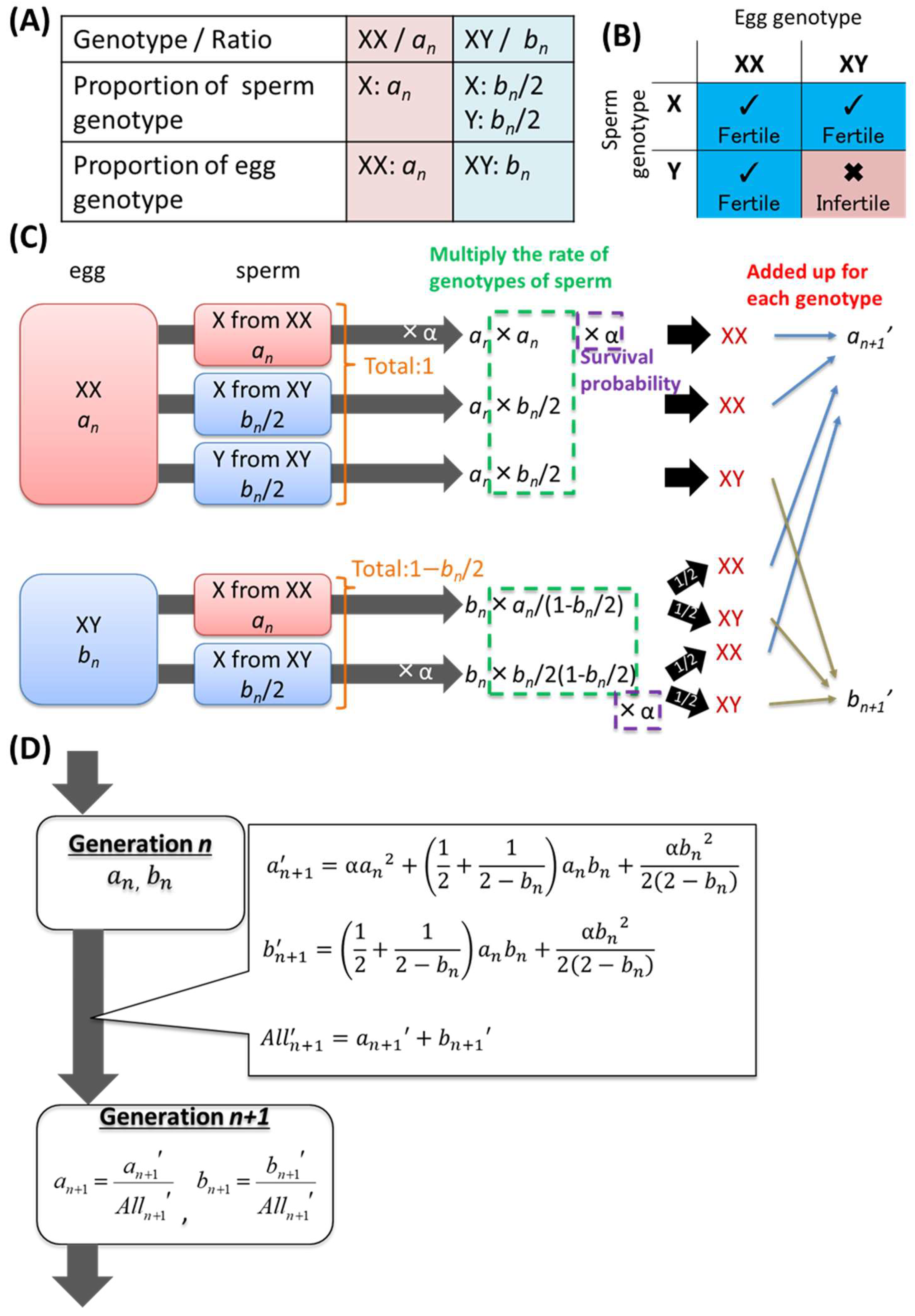
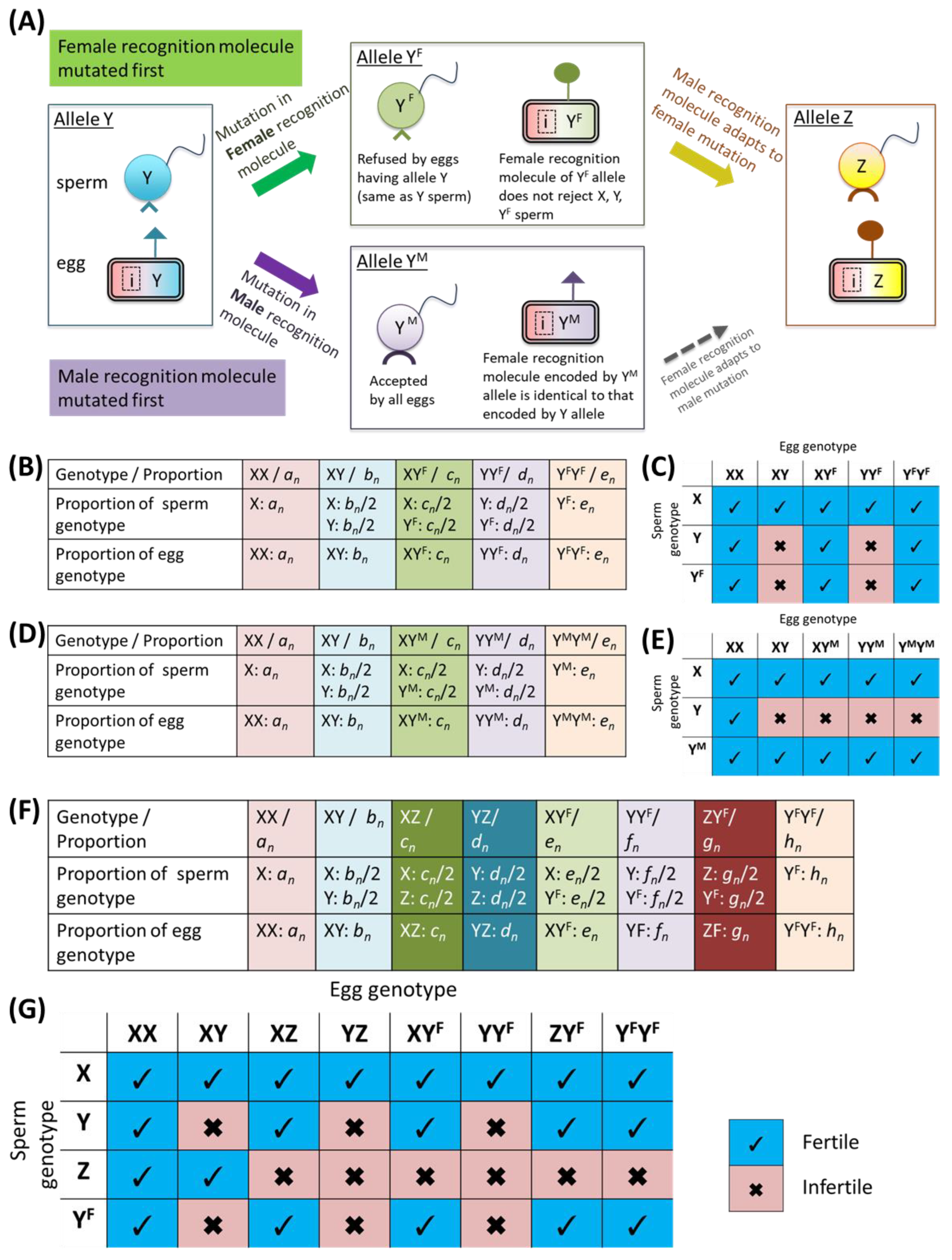
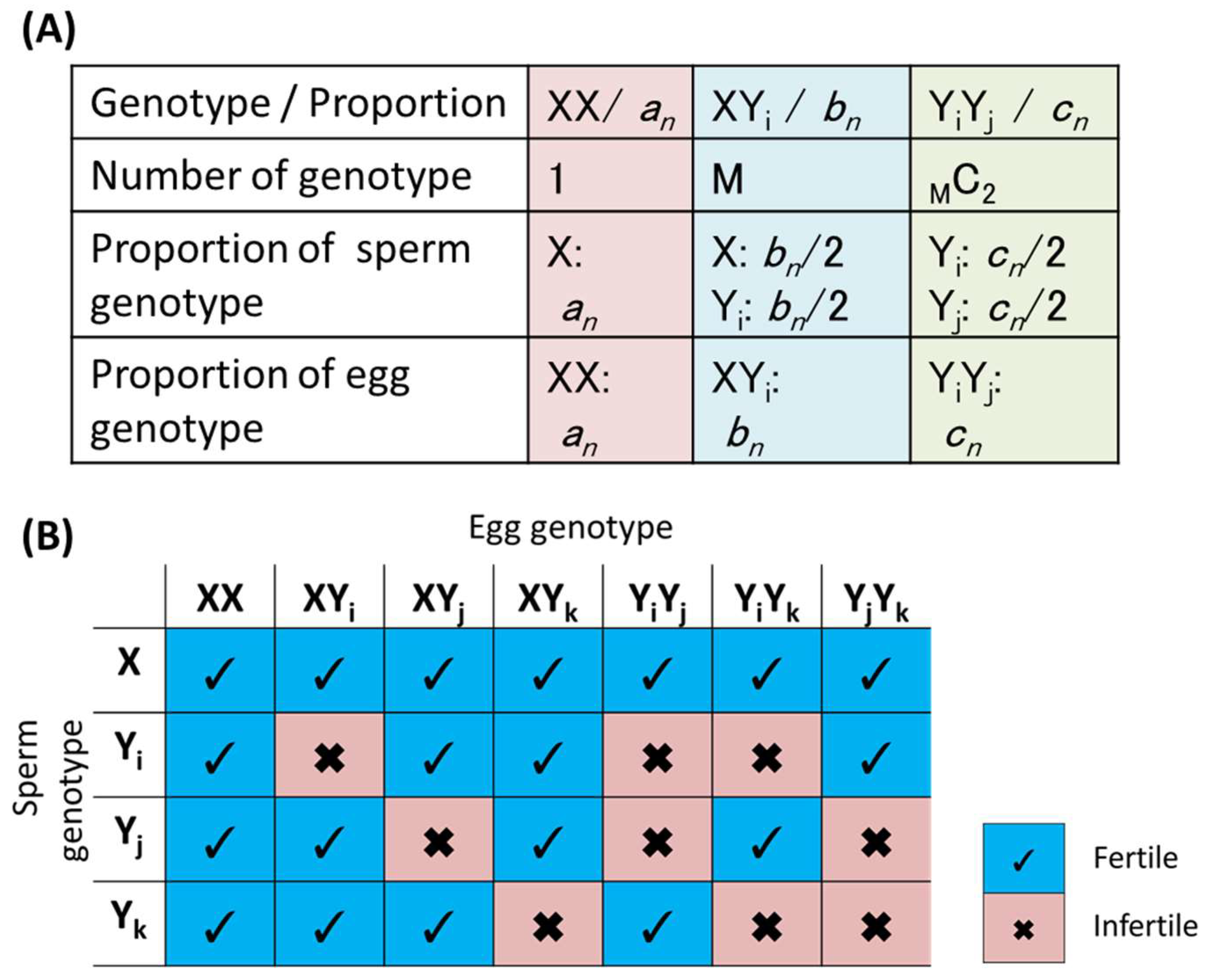
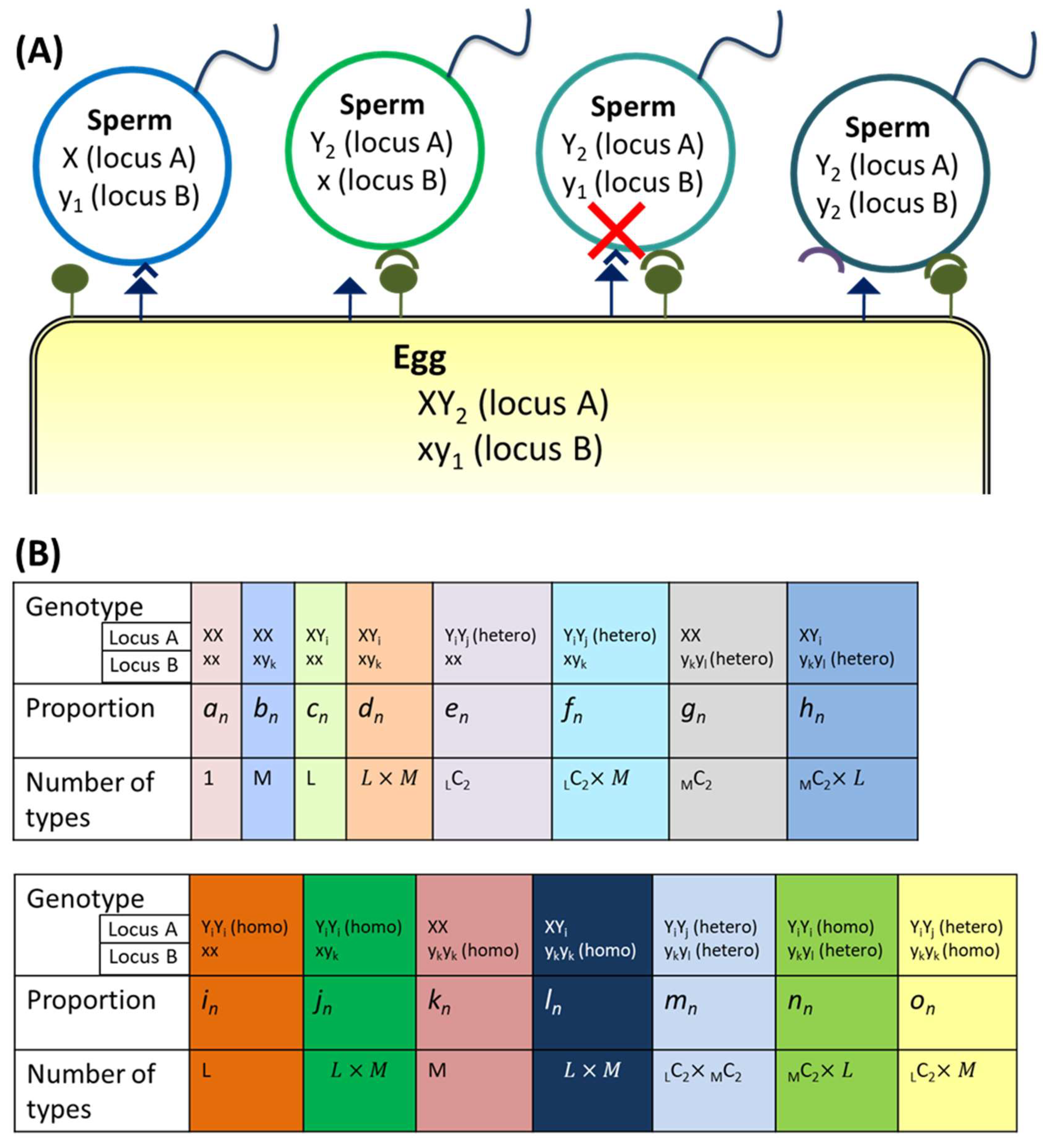

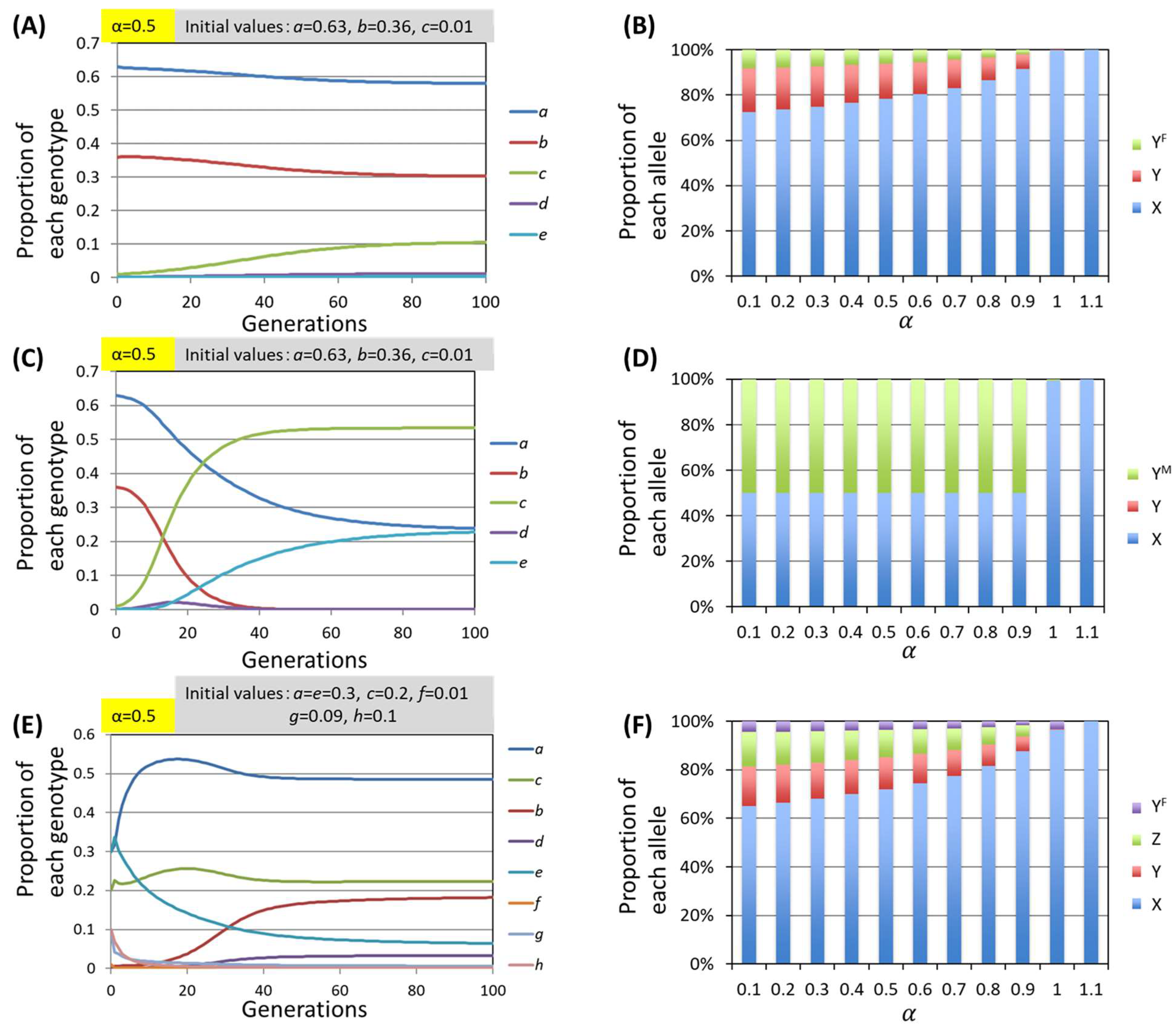


| Proportion of the Genotype XX (Simulation After 1000 Generations) | Proportion of the Genotype XX (Analytical Solution) | |
|---|---|---|
| 1.1 | 1 | 1 |
| 1 | 0.99802 | 1 |
| 0.9 | 0.85817 | 0.85817 |
| 0.7 | 0.71484 | 0.71484 |
| 0.5 | 0.63122 | 0.63122 |
| 0.3 | 0.57086 | 0.57086 |
| 0.1 | 0.52199 | 0.52199 |
| 0.01 | 0.50215 | 0.50215 |
| M | Simulation After 1000 Generations | Analytical Solution | |||||
|---|---|---|---|---|---|---|---|
| a | b | c | a | b | c | ||
| 5 | 0.1 | 0.2193 | 0.1108 | 0.0227 | 0.2193 | 0.1108 | 0.0227 |
| 5 | 0.5 | 0.3128 | 0.1064 | 0.0155 | 0.3128 | 0.1064 | 0.0155 |
| 5 | 0.8 | 0.4734 | 0.0898 | 0.0078 | 0.4738 | 0.0898 | 0.0077 |
| 10 | 0.1 | 0.1468 | 0.0509 | 0.0076 | 0.1465 | 0.0509 | 0.0077 |
| 10 | 0.5 | 0.2165 | 0.0526 | 0.0057 | 0.2158 | 0.0526 | 0.0057 |
| 10 | 0.8 | 0.3529 | 0.0499 | 0.0033 | 0.3496 | 0.05 | 0.0033 |
| 15 | 0.5 | 0.1759 | 0.034 | 0.003 | 0.1722 | 0.0339 | 0.003 |
Disclaimer/Publisher’s Note: The statements, opinions and data contained in all publications are solely those of the individual author(s) and contributor(s) and not of MDPI and/or the editor(s). MDPI and/or the editor(s) disclaim responsibility for any injury to people or property resulting from any ideas, methods, instructions or products referred to in the content. |
© 2025 by the authors. Licensee MDPI, Basel, Switzerland. This article is an open access article distributed under the terms and conditions of the Creative Commons Attribution (CC BY) license (https://creativecommons.org/licenses/by/4.0/).
Share and Cite
Naruse, M.; Saito, T.; Matsumoto, M. Population Genetics of the Emergence and Evolution of Allogenic Recognition During Fertilization. Biomolecules 2025, 15, 1397. https://doi.org/10.3390/biom15101397
Naruse M, Saito T, Matsumoto M. Population Genetics of the Emergence and Evolution of Allogenic Recognition During Fertilization. Biomolecules. 2025; 15(10):1397. https://doi.org/10.3390/biom15101397
Chicago/Turabian StyleNaruse, Masahiro, Takako Saito, and Midori Matsumoto. 2025. "Population Genetics of the Emergence and Evolution of Allogenic Recognition During Fertilization" Biomolecules 15, no. 10: 1397. https://doi.org/10.3390/biom15101397
APA StyleNaruse, M., Saito, T., & Matsumoto, M. (2025). Population Genetics of the Emergence and Evolution of Allogenic Recognition During Fertilization. Biomolecules, 15(10), 1397. https://doi.org/10.3390/biom15101397







